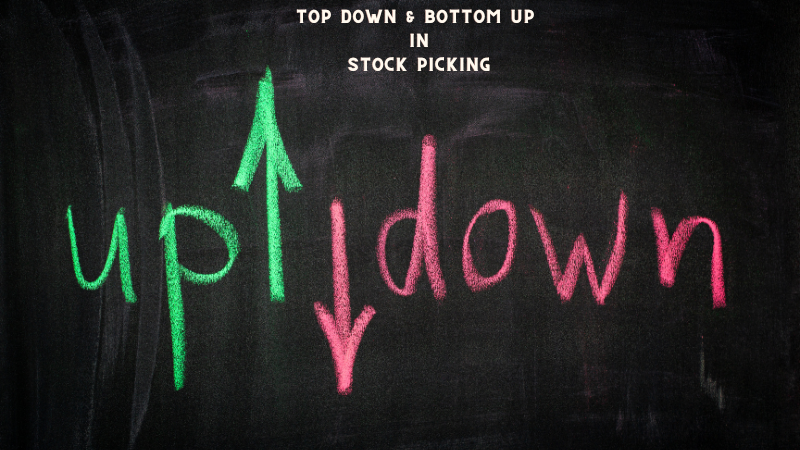
The terms top-down approach and bottom-up approach are terms that are often associated with the fundamental analysis of stocks. This involves a series of steps or procedures for researching the stocks and creating an investment portfolio that is uniquely based on the individual preferences of risk-return analysis. The seated meaning of these approaches and how they benefit investors are mentioned hereunder.
What is the top-down approach?
The top-down approach is the analysis of the stocks from the macro level to the ground level. It can also be referred to as the bird’s eye view type of analysis. Investors in this type of analysis focus on the EIC form of analysis to understand the performance of a stock. It refers to the three-step analysis of stock following the analysis of the economy first, which is then shifted to the industry that the company belongs to, and finally the target company.
The investor has to first analyse the economic condition of the country and the global economic conditions to understand if it is suitable for investment currently. The next step is to analyse the core industry focusing on the key parameters that affect it as a whole. At the same time, investors should also focus on the risks and opportunities that are inherent to the industry which is essential to determine the investing opportunities.
Finally, the focus is then shifted to the company itself. Investors should analyse the financial performance of the company over the past years, its growth opportunities, capital structure, and key ratios like the ROCE, ROE, EPS, PE Ratio, etc. These parameters are then to be compared with the competition in the industry to evaluate the relative performance of the company and its growth trajectory.
What is the bottom-up approach?
The bottom-up approach is the exact reverse of the top-down approach where the focus is on the individual stock rather than the macro perspective. Under this approach, the company is the starting point of analysis where the investor reviews the target company on various aspects like its fundamentals, its relative position in the industry, their competition, etc.
While analysing the fundamentals of the company, the focus of the investors should be on the revenues of the company, its business model, and the market position of the products or services offered by the company and its life cycle. The other area of focus in fundamental analysis is the quality of the management that is at the helm of the business operations and their ability to navigate the business through any tough spot. It also includes an analysis of the key ratios of the business and comparing them to the competitors in the industry.
The next step in the bottom-up approach is analysing the sector that the company belongs to. This type of sector analysis again includes the risks and opportunities of the sector as a whole followed by analysing of the economic conditions of the country and the global economy. The movement of going from the micro factors affecting the performance of the stock to the macro factors is the core of the bottom-up approach in stock selection. This approach allows the investor to primarily focus on the stock and then move upwards. It is not necessary that the performance of the stocks picked may be in sync with that of the sector or the economy as a whole. However, this does not make them a poor investment option.
When to use the top-down and bottom-up approaches?
The top-down approach focuses on the larger dynamics that affect the stock prices and the movement of the stock in the market. This enables the investors to understand the valuation and the demand for a particular stock based on the demand for the sector or the industry as a whole and then determine its relative performance. Such a type of analysis is crucial in the case of investing in sector funds and in the case of investors picking stocks based on sector fluctuations.
The bottom-up approach is the process of picking quality stocks from the available options and analysing their price movements based on different market trends. Bottom-up stocks work better in the analysis of mid-cap stocks and small-cap stocks that have the opportunity to outperform the market. These companies have the potential to become market leaders in the future in the backdrop of significant innovation or breakthroughs in the industry or creating a niche for themselves in the market against the prevailing competition.
Conclusion
The top-down approach and bottom-up approach are both equally beneficial for investors to analyse the stocks to create a profitable portfolio. However, as the name suggests, these approaches are absolutely diverse and require different mindsets, focus, and understanding of the market, the company, and the economy to successfully curate an investment portfolio that meets all the financial goals of the investors.
FAQs
The focus in picking stocks under a top-down approach is first the performance of the economy followed by targeting a sector and then the top performing stocks in such sector
The prime advantage of picking stocks through a bottom-up approach is having an opportunity to be part of the growth story of mid-cap or small-cap stocks that have the potential to outperform the industry or the market s a whole
There is no specific answer or a better approach to stock selection between the top-down approach and the bottom-up approach. It depends on the investor and their understanding of various parameters that ultimately lead to stock selection. The ideal answer to this question is using a combination of the two to create a healthy portfolio that can help in spreading the risk of the overall portfolio.
Some of the key factors to consider in using top-down approach to stock selection is the considering the GDP of the country, interest rates, political stability, government policies, tax structure, industry growth rate, challenges and opportunities in the industry, entry and exit barriers in the industry, competitors, company fundamentals, quality of management, demand for the stock, etc


























